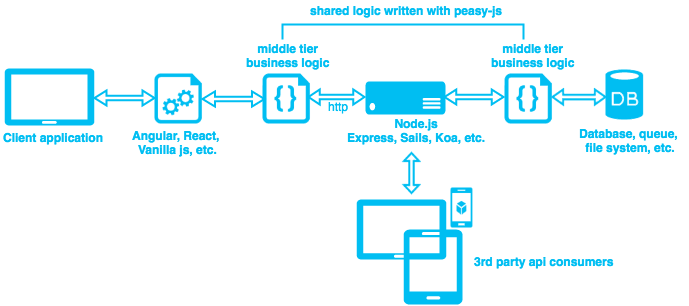Write Reusable JavaScript Business Logic with peasy-js was peer reviewed by Stephan Max. Thanks to all of SitePoint’s peer reviewers for making SitePoint content the best it can be!

When writing applications, we often couple our valuable business logic with framework specific code. For example, when using Angular it is common to disperse business logic across services, controllers, and even directives.
This also applies to JavaScript written for the back-end, where it common to litter our Sails (for example) controller actions with business logic that directly consumes our data access logic via ORM/ODMs such as Mongoose, and other cross-cutting concerns.
This coupling generally leads to code that is difficult to reuse, scale, test, and adopt or migrate to new technologies.
In this article, I’ll show you how to use the peasy-js library to help structure your business logic in a way that makes it highly re-usable between the front and back-end parts of your app, and easily portable between different frameworks.
Disclosure: I am the author of peasy-js
Should We Stop Using Frameworks?
On the contrary, I believe these frameworks offer tremendous benefit, both on the client and server. What I am proposing, however, is to abstract our business logic into composable units by creating code that is completely agnostic of its consumers.
By componentizing our business logic, we can easily test, swap out, rearrange, reuse, and consume these components within any application architecture, using any JavaScript client, server, data access technologies, and framework imaginable.
Separate Your Business Logic
peasy-js is a middle-tier framework that makes it trivial to whimsically swap out UI, back-end, and data access frameworks in our applications by creating business logic in a composable, reusable, scalable, and testable manner. In other words, peasy-js offers guidance in abstracting our business logic into composable units by authoring code that adheres to separation of concerns (SoC).
Framework Fatigue
Wait, don’t go yet!
I know what you’re thinking, “ugh, another framework?”. Yes, peasy-js is indeed a microframework. However, chances are if we venture down the path of componentizing our business logic, we’ll end up writing our own micro framework anyhow.
Countless hours have been contributed to the design, development, and testing of peasy-js, supporting almost any workflow imaginable. With a low barrier to entry, I’m hopeful that you’ll find the small investment in learning to be well worth your time.
If however, you find that peasy-js isn’t quite for you, hopefully you’ll gain some insight into how you can implement your own business layer using some of the patterns in the framework.
The Main Concepts
Let’s check out what peasy-js offers us:
- Easy to use and flexible business and validation rules engine
- Scalability and reusability (decouples business and validation logic from consuming code and frameworks)
- Easy testability
peasy-js encompasses four main concepts. Each one is outlined below with a brief description and will be covered in more depth throughout the article.
BusinessService
A BusinessService implementation represents an entity (e.g. users, or projects) and is responsible for exposing business functionality via commands. These commands encapsulate CRUD and other business related functions.
Command
The Command is responsible for orchestrating the execution of initialization logic, validation and business rule execution, and other logic (data proxy invocations, workflow logic, etc.), respectively, via the command execution pipeline.
Rule
A Rule can be created to represent a validation rule (field length or required) or a business rule (authorization, price validity, etc.). Rules are consumed by commands and can be chained, configured to execute based on a previous rule’s execution, etc. Rules can also be configured to run code based on the result of their execution.
DataProxy
The DataProxy is responsible for data storage and retrieval, and serves as an abstraction layer for data stores that encompass (but are not limited to) the following:
- Relational Databases – SQLite, MySQL, Oracle, SQL Server, etc.
- Document (NoSQL) Databases – MongoDB, VelocityDB, etc.
- Services – HTTP, SOAP, etc.
- Cache Stores – Redis, Azure, etc.
- Queues – RabbitMQ, MSMQ, etc.
- File System
- In-memory data stores for testing
Examples: Peasy-js in Action
Note: A simple browser example can be viewed on plnkr that covers everything discussed in this section.
Here is a sample of what it might look like to consume business logic written with peasy-js within an Angular service on the client:
Figure A
var dataProxy = new CustomerHttpDataProxy();
var service = new CustomerService(dataProxy);
var customer = { name: "Frank Zappa", birthDate: new Date('12/21/1940') };
var command = service.insertCommand(customer);
command.execute(function(err, result) {
if (result.success) {
customer = result.value;
} else {
console.log(result.errors);
}
});
Now let’s look at an example of what it might look like to consume the same business logic within an Express.js controller on the server:
Figure B
var dataProxy = new CustomerMongoDataProxy();
var service = new CustomerService(dataProxy);
var customer = { name: "Frank Zappa", birthDate: new Date('12/21/1940') };
var command = service.insertCommand(customer);
command.execute(function(err, result) {
if (result.success) {
customer = result.value;
} else {
console.log(result.errors);
}
});
Notice a difference? The beautiful thing is that there is no difference, excepting a different data proxy injected into the business service in each sample.
Remember that a data proxy is our data access abstraction and can represent a concrete implementation of file system access, database, queue, cache, in-memory, and HTTP communications.
This abstraction allows us to swap out data proxies based on desired system architectures and configurations, while enforcing SoC and lending itself to reuse across codebases and facilitating easier testing. What may not be immediately obvious is that this approach always subjects our payloads to the same business logic, regardless of the source or destination of our data. This will all reveal itself soon.
From a consumption standpoint, that really is all there is to it. Consuming our business logic developed with peasy-js will introduce a recognizable theme, regardless of our architecture and the technologies that consume it.
Speaking of architecture, let’s turn our attention to a potential architecture that becomes easily achievable when developing our business logic in this manner while exploring the peasy-js participants a bit more in depth:

From left to right, we see that a client application consumes a framework such as Angular, React, Backbone, etc. To achieve maximum scalability, notice that we can move the business logic implementation from the UI framework participant implementations (services, controllers, etc.) into its own componentized codebase, or middle-tier.
Next, notice that the middle-tier communicates with the web server. This is made possible by the presence of data proxies. Referring to figure A, the Angular service consuming our business logic instantiates a CustomerHttpDataProxy. As a result, when the insert command is executed, it subjects the supplied payload to any business rules that have been configured. In the event of successful validation, the corresponding insert function of our data proxy will be invoked, and issue a POST request against our configured customer endpoint accordingly.
Conversely, notice that the same business logic consumed in our front end is also consumed by our node.js application. Referring to figure B, the express controller consuming our business logic instantiates a CustomerMongoDataProxy. However, this time when the insert command is executed, the corresponding insert function of our data proxy will perform an INSERT against our database, using the MongoDB API or an ORD, such as Mongoose.
Lastly, because our data proxy implementations adhere to the same interface, we can inject them into our business services depending on how we want to deploy our application. In the diagram, the business services consume data proxies that interact with HTTP services on the client. However, once a request is handled by the web API, the same business services hosted by Node.js are injected with data proxies that interact with a database, queue, cache, file system, etc.
Now that we understand the peasy-js participants from a high level and some of the benefits that they provide, let’s walk through example implementations of them.
CustomerHttpDataProxy
var CustomerHttpDataProxy = function() {
var request = require('request');
return {
insert: insert
};
function insert(data, done) {
request({
method: 'POST',
url: 'http://localhost:3000/customers',
body: data,
json = true
}, function (error, response, body) {
done(error, body);
}
);
};
};
CustomerMongoDataProxy
var CustomerMongoDataProxy = function() {
var connectionString = 'mongodb://localhost:12345/orderEntry';
var mongodb = require('mongodb').MongoClient;
return {
insert: insert
};
function insert(data, done) {
mongodb.connect(connectionString, function(err, db) {
if (err) { return done(err); }
var collection = db.collection('customers');
collection.insert(data, function(err, data) {
db.close();
done(err, data);
});
});
};
};
In these data proxy code examples, notice that they adhere to the same interface but abstract away the implementation logic. This is what allows us to scale our application. We can see by swapping data proxies that we now have a truly reusable middle tier that is completely agnostic of any consuming code (client or server). This data proxy design concept is really key to achieving scalability and easy testability.
Lastly, notice that for brevity we’ve only defined an insert function in our data proxies. However, in a real production environment, we would most likely expose all CRUD operations, and perhaps a few more. You can see a full implementation of the CustomerMongoDataProxy here.
CustomerService
var CustomerService = BusinessService.extend({
functions: {
_onInsertCommandInitialization: function(context, done) {
var customer = this.data;
utils.stripAllFieldsFrom(customer).except(['name', 'address']);
utils.stripAllFieldsFrom(customer.address).except(['street', 'zip']);
done();
}
}
}).service;
In this example, we’ve provided initialization logic for the CustomerService’s exposed insertCommand that whitelists fields before a call to our data proxy’s insert function is invoked. Each default CRUD operation exposed via our business service implementations expose event hooks associated with each command. These methods can be viewed here.
Notice that we use the static BusinessService.extend function, which creates a constructor function exposed via the service member of the returned object. You are also free to use ES6 inheritance or prototypal inheritance if you are more comfortable with these approaches. Samples of both can be found here.
Now that we’ve defined our initialization logic for our business service’s insertCommand, let’s create a couple of rules and wire them up accordingly:
NameRule
var NameRule = Rule.extend({
association: "name",
params: ['name'],
functions: {
_onValidate: function(done) {
if (this.name === "Jimi") {
this._invalidate("Name cannot be Jimi");
}
done();
}
}
});
AgeRule
var AgeRule = Rule.extend({
association: "age",
params: ['birthdate'],
functions: {
_onValidate: function(done) {
if (new Date().getFullYear() - this.birthdate.getFullYear() < 50) {
this._invalidate("You are too young");
}
done();
}
}
});
Notice that we use the static Rule.extend method in both code examples, which creates a constructor function for us. As before, you can also use ES6 or prototypal inheritance (examples here).
Now let’s wire them up in our CustomerService:
Wiring up our rules
var CustomerService = BusinessService.extend({
functions: {
_onInsertCommandInitialization: function(context, done) {
var customer = this.data;
utils.stripAllFieldsFrom(customer).except(['name', 'address']);
utils.stripAllFieldsFrom(customer.address).except(['street', 'zip']);
done();
},
_getRulesForInsertCommand: function(context, done) {
var customer = this.data;
done(null, [
new NameRule("name", customer.name),
new AgeRule("age", customer.birthDate)
]);
}
}
}).service;
In our final piece of code, we’ve wired up our rules in our business service and have injected them into our insert command execution pipeline. We’ve done this by supplying an implementation for the _getRulesForInsertCommand() function.
In this sample, we have configured both rules to execute regardless of the outcome of one one another. For example, if the NameRule validation fails, the AgeRule will still be evaluated, and vice versa.
What’s great about peasy-js rules is that they are extremely flexible and can be written and configured to support almost any scenario imaginable. For example, we could chain the rules’ execution in a way that only executes AgeRule in the event that the NameRule validation succeeds, and vice versa. This is extremely useful when our rules need to acquire data from a data store (a potentially expensive hit).
More information on rules can be found in the documentation.
Testing our business logic
Because peasy-js adheres to SOLID programming principles, it becomes very easy to test our business services, commands, and rules.
Let’s look at how we can easily test our NameRule:
it("fails when the supplied name is Jimi", () => {
var rule = new NameRule("Jimi");
rule.validate(() => {
expect(rule.valid).toBe(false);
expect(rule.association).toEqual("name");
});
});
it("succeeds when the supplied name is not Jimi", () => {
var rule = new NameRule("James");
rule.validate(() => {
expect(rule.valid).toBe(true);
});
});
By keeping our rules simple and focused, not only do they become easy to reuse, but also extremely easy to test. This also applies to testing our business services and custom commands.
Testing is a large topic in and of itself, so this is a good ending point for the article. Just note that testing our business logic with peasy-js is extremely easy, and many test samples can be found here.
Want to learn more?
An entire order entry / inventory management sample application is available that showcases a middle-tier written with peasy-js. The business logic is consumed by an Express.js application hosted in Node.js, which exposes a web API. The sample is easy to run and is accompanied by documentation to help get you up and running in minutes.
peasy-js encourages us to write our business logic that is cleanly separated from the the frameworks we use. A beneficial side-effect of this is that it makes it easy to deploy our code in a multitude of ways. Lastly, it makes it almost trivial to migrate to or adopt new frameworks as our current frameworks age.
Do you follow any similar patterns in your apps? Do you think using something like peasy-js would help you to write better code? Let me know what you think below in the comments!
Frequently Asked Questions about Reusable JavaScript Business Logic with Peasy-JS
What is the main advantage of using Peasy-JS for business logic?
Peasy-JS is a middle-tier framework that is designed to manage business logic for JavaScript applications. The main advantage of using Peasy-JS is that it allows for the creation of reusable and maintainable business logic. This means that developers can write code once and use it across multiple projects, saving time and effort. Additionally, Peasy-JS supports multiple client frameworks, making it a versatile choice for developers working with different technologies.
How does Peasy-JS compare to other JavaScript frameworks?
Unlike many other JavaScript frameworks, Peasy-JS is specifically designed to handle business logic. This makes it a powerful tool for developers who need to manage complex business rules and workflows. While other frameworks may offer similar functionality, Peasy-JS stands out for its focus on business logic and its ability to be reused across projects.
Can Peasy-JS be used with other programming languages?
Peasy-JS is a JavaScript framework, so it is primarily designed to be used with JavaScript. However, because it is a middle-tier framework, it can be used with any client-side technology that can communicate with a JavaScript server. This includes other programming languages that can interact with JavaScript, such as Python or Ruby.
How does Peasy-JS handle data validation?
Peasy-JS has built-in support for data validation. It allows developers to define validation rules for their business objects, which are then automatically enforced by the framework. This ensures that all data is valid before it is processed, helping to prevent errors and maintain data integrity.
What is the learning curve for Peasy-JS?
As with any new technology, there is a learning curve when starting with Peasy-JS. However, the framework is designed to be intuitive and easy to use, with a clear and straightforward API. Additionally, there are many resources available, including documentation and tutorials, to help developers get started.
Can Peasy-JS be used for large-scale projects?
Yes, Peasy-JS is well-suited for large-scale projects. Its focus on reusable business logic makes it an excellent choice for complex applications with many business rules. Additionally, because it is a middle-tier framework, it can handle high loads and scale with the needs of the project.
How does Peasy-JS support testing?
Peasy-JS is designed with testing in mind. It supports unit testing and integration testing, allowing developers to ensure that their business logic is working correctly. This makes it easier to catch and fix bugs early in the development process, leading to more stable and reliable code.
Is Peasy-JS open source?
Yes, Peasy-JS is an open-source project. This means that it is free to use and developers can contribute to its development. The source code is available on GitHub, where developers can report issues, suggest features, and submit pull requests.
How is Peasy-JS maintained and updated?
Peasy-JS is maintained by a community of developers who are dedicated to improving and updating the framework. Updates are released regularly, with new features and improvements based on feedback from the community. This ensures that Peasy-JS stays up-to-date with the latest trends and technologies in the JavaScript ecosystem.
Where can I find more resources to learn about Peasy-JS?
There are many resources available to learn about Peasy-JS. The official documentation is a great place to start, as it provides a comprehensive overview of the framework and its features. Additionally, there are many tutorials and blog posts available online that provide practical examples and tips for using Peasy-JS.
Lover of all things javascript. I enjoy designing and developing software both professionally and leisurely. Alot...






